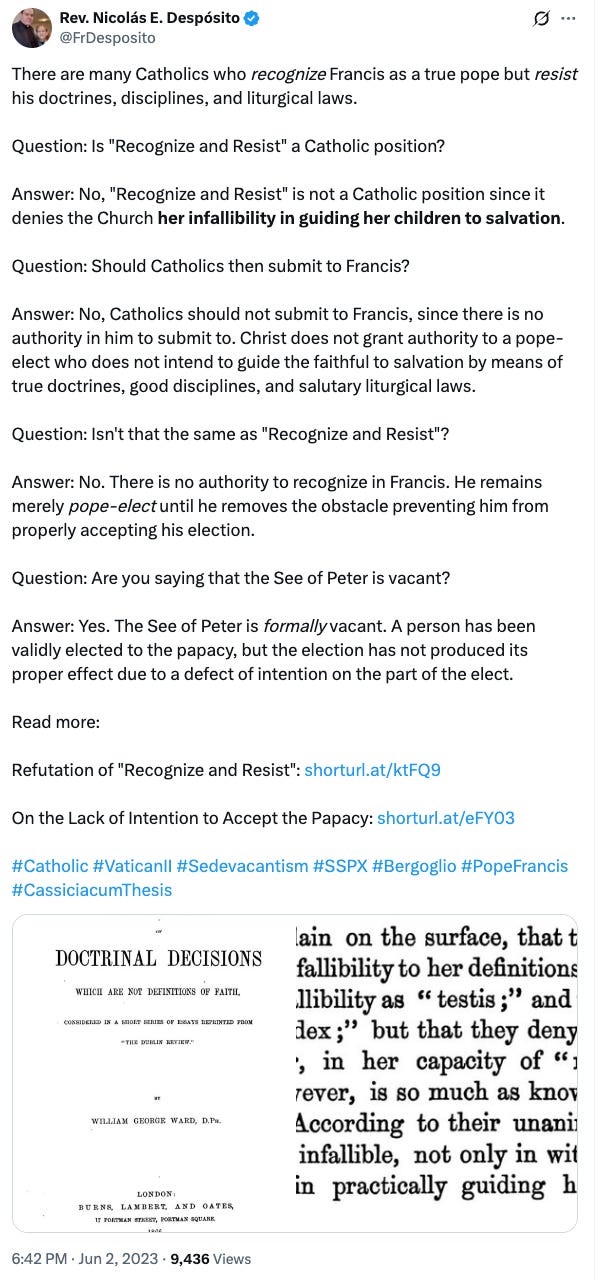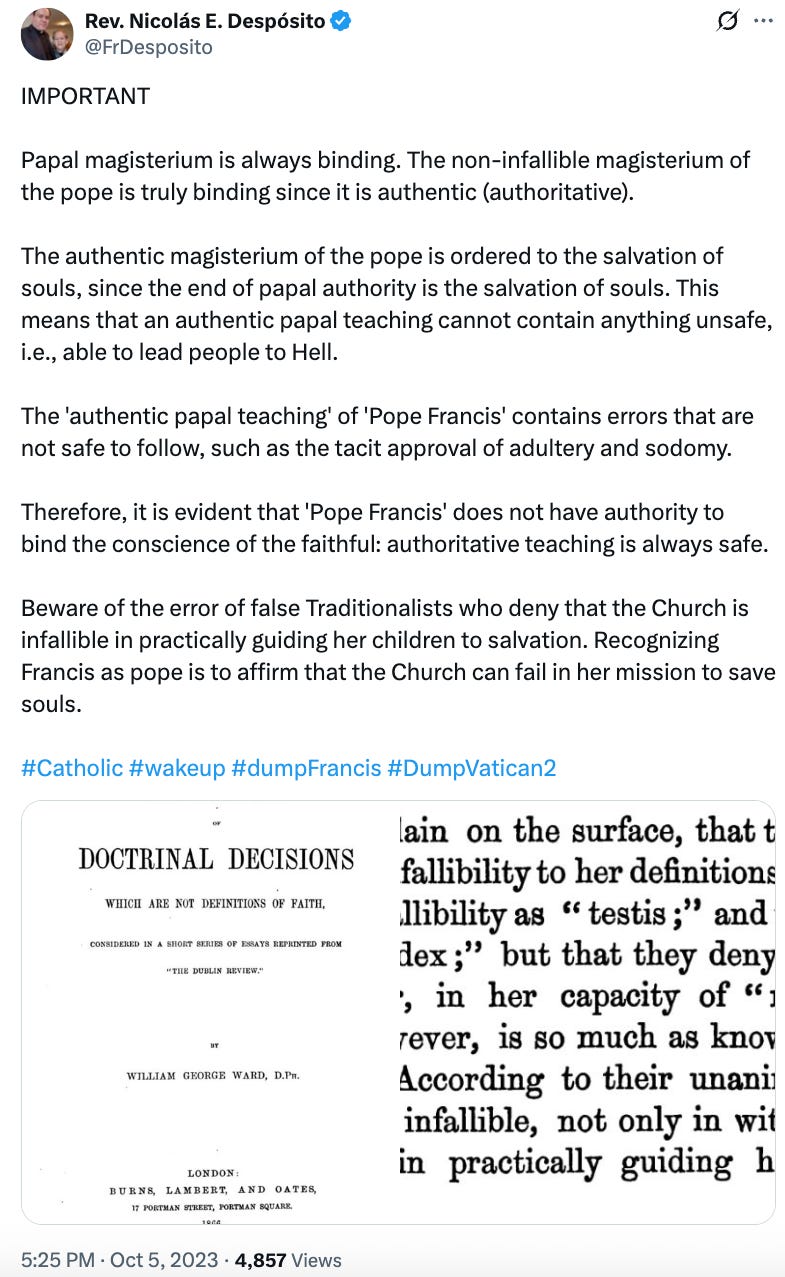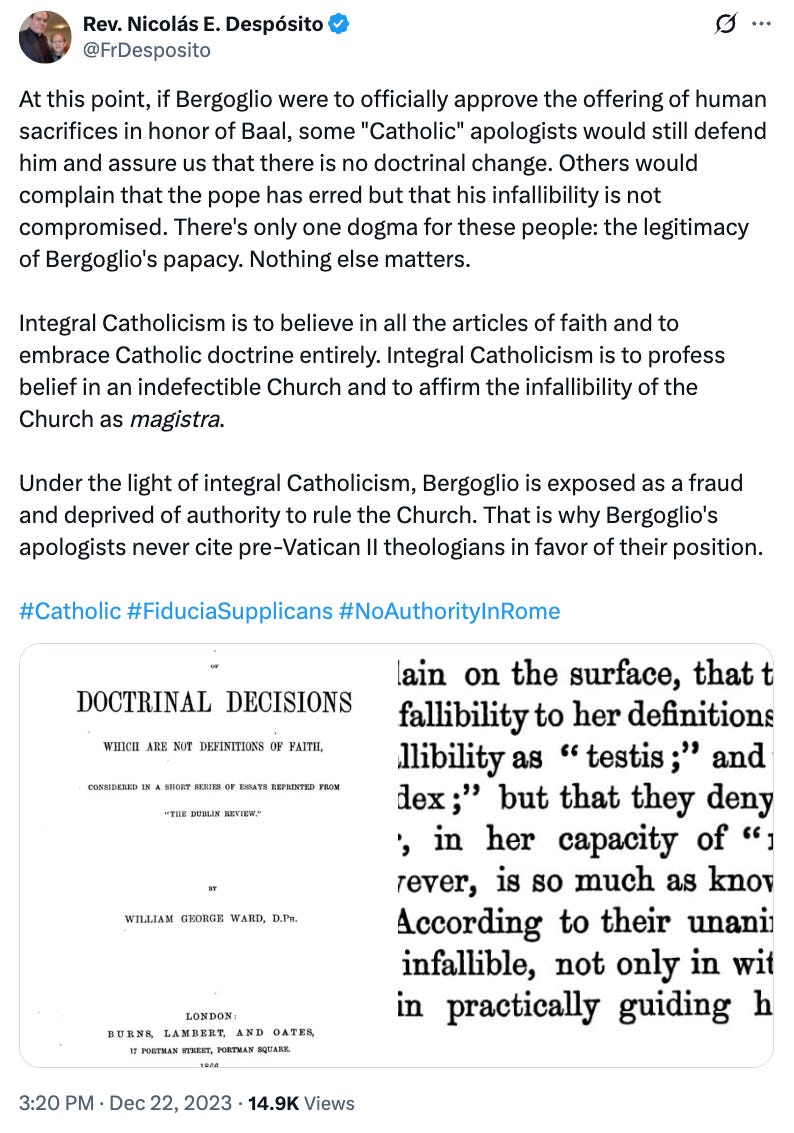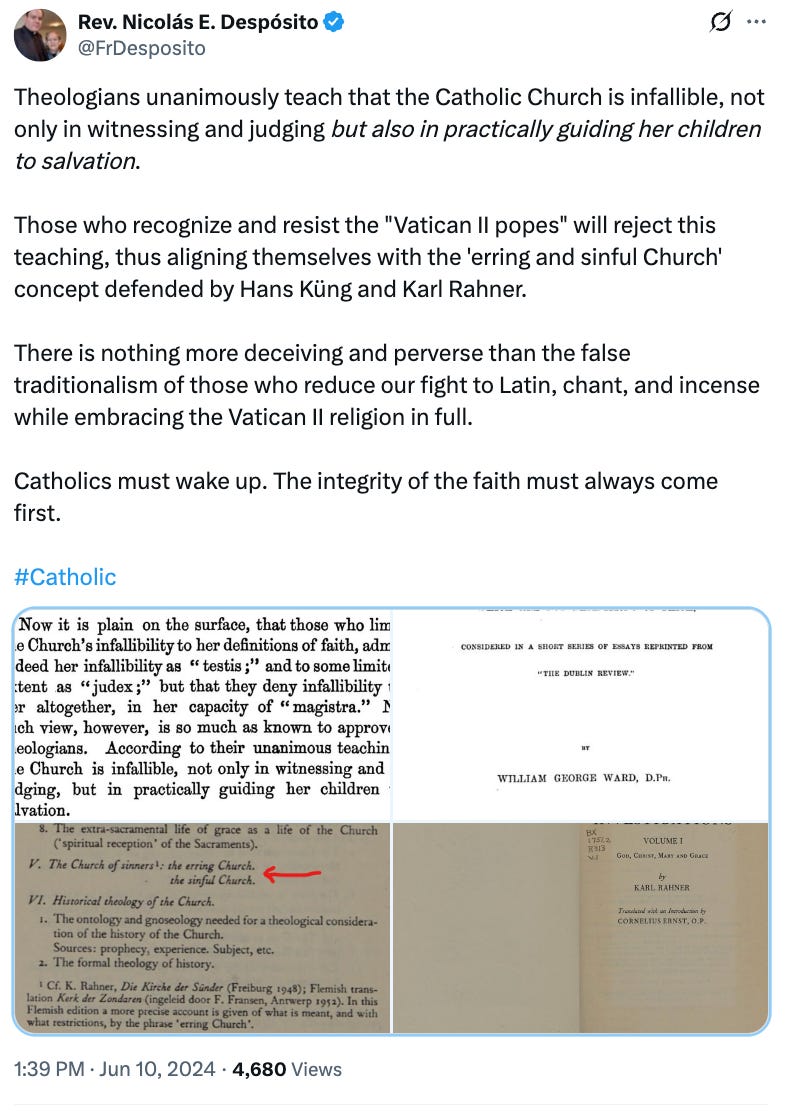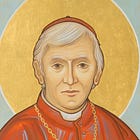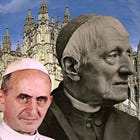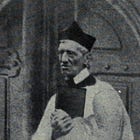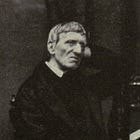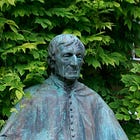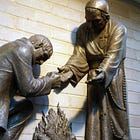Bishop Sanborn’s attempt to link Cardinal Newman with Baron von Hügel
If Cardinal John Henry Newman 'guilty by association' with Baron von Hügel, then what is the evidence for their supposedly close friendship?

Introduction
This is an addendum to the previous pieces answering Bishop Sanborn’s criticisms of Cardinal John Henry Newman. It was originally a response to a video made in November 2022, in which the Bishop accused Newman of having “remained a Protestant down deep” and of holding modernist principles and ideas about conscience.
I have demonstrated the injustice of these accusations here, here and here. Having addressed the main points made in this video, and having called for its creators to remove it and retract its claims, this piece addresses Bishop Sanborn’s innuendo about Newman being “very friendly” with Baron Friedrich von Hügel.
Bishop and Cardinal Mini-Series
Part I: Is Cardinal Newman’s idea of conscience ‘precisely modernist,’ as Bishop Sanborn claims?
Part IIa: Bishop Sanborn, and Cardinal Newman’s ‘Proof from Conscience’
Part III: Bishop Sanborn’s attempt to link Cardinal Newman with Baron von Hügel
Baron von Hügel
The accusation ran as follows:
Bishop Sanborn: “And he was very friendly with von Hügel, [disgusted face] who was a German (sic) living in England, who was an arch-modernist, the devil himself, practically, as regard to modernism.
“And Newman always just stayed on this side of the demilitarised zone, so to speak, [Interviewer laughing] in order to avoid the accusation of modernism.
“But his principles are modernist. That idea of conscience is precisely modernist.”
As mentioned, I have already shown the falsity of the final statement – that Newman’s ideas of conscience were ‘precisely modernist’. His ideas were, in fact, the same as Bishop Sanborn’s.
Let us being note that Bishop Sanborn has made a similar claim about von Hügel and Newman before, in an article on his blog. While this claim did there enjoy the presence of a footnote, the footnote provided no evidence of such association or even mention of von Hügel. Instead, it merely consisted of an extract from one of Newman’s Anglican works, which the Bishop called “thoroughly modernist” and comparable to “the arch-modernist excommunicate Alfred Loisy.”1
Needless to say, this is irrelevant, and does not prove anything about Newman as a Catholic – nor that he was ‘very friendly’ with von Hügel.
As we have previously noted, the updating and un-redaction of this essay in September 2025 was occasioned by Bishop Sanborn renewing these calumnious remarks, following Leo XIV’s decision to make Newman a Doctor of the Church. In his August 2025 newsletter, Bishop Sanborn added the name of Tyrell:
“Because Newman emphasized this interior experience of God, the modernists looked to him as their intellectual leader. This was especially true of Tyrrell and Von Hügel, and to a lesser extent Loisy, all arch-modernists, Tyrell and Loisy having been excommunicated.”
Before proceeding to our consideration of Newman’s supposed friendship with von Hügel, let us cite Cardinal Alexis Lépicier. Lépicier was a critic of Newman, and yet had harsh words for Tyrrell’s claim about Newman’s relationship with modernism:
“[I]t was only by calumny that George Tyrrell wrote most recently:
“‘The solidarity of Newmanism with Modernism cannot be denied. Newman might have shuddered at his progeny, but it is none the less his.’” etc.
If Lépicier is not sufficient, would Pope St Pius X suffice? Writing to Bishop O’Dwyer on this very topic, he wrote:
“[T]he Modernists, in twisting [Newman’s] words to their own sense, contrary to the whole context, are guilty of falsity and deceit.”2
If neither Cardinal Lépicier nor Pope St Pius X suffice, we must ask what would be sufficient – or if, in fact, any evidence is capable of shaking this belief.
In any case, let us proceed.
That which is asserted without evidence, falls with a simple denial.
We deny 1) that Newman was ‘very friendly’ with von Hügel in the sense implied by such accusations, and 2) that, even if he was ‘very friendly’ with him, such a relationship would in itself taint Newman by association, in the way that Bishop Sanborn’s innuendo implies.
Those who wish to make such attacks on the reputation of others – especially those who cannot defend themselves – should provide evidence, which can then be weighed. In the absence of evidence, these claims fall with a simple denial.
While we await such evidence, here are the facts.
Von Hügel was an Austrian (not German) aristocrat. His was a prominent family, as was that of his wife.
It may be difficult for us today, in a more “egalitarian” society, to understand the real importance and influence that certain aristocratic families had, and the corresponding moral duties which clergymen might hold towards them.
Von Hügel’s mother-in-law was a very well-connected Catholic convert, and the baron’s biographer states that Newman and Vaughan thought that the marriage was a good match.3 But even on religious grounds (to say nothing of natural) this is entirely understandable: when they married in his early twenties, before a lifetime of intellectual work revealing the way his mind turned, von Hügel was considered to be a thoughtful and externally pious young man.4
On the subject of age: von Hügel was 51 years Newman’s junior. Such an age difference makes for a rather improbable (though not impossible) basis for the two men to have been “very friendly” in the sense implied by the Bishop.
Letters exchanged
It is true that Newman exchanged letters with von Hügel – as both men did with very many others, and as was much more common at the time than it is today. Drawing conclusions about who was “very friendly” with whom based on letter-writing, might be akin to drawing the same conclusions based on email correspondence today. We all know that this would be unsound.
These letters – as with all Newman’s letters – could perhaps be described as being “very friendly,” in that they were written properly, and were respectful, polite and occasionally warm. Those who are not used to writing in proper form might draw unwarranted conclusions from this. But it should be clear that interacting with someone in a way governed by basic manners and warmth is not the same as being “very friendly” in the sense insinuated.
In fact, reading between the lines of some of Newman’s surviving correspondence, it seems that he was trying to help von Hügel stay “in the light,” so to speak.5
Further, von Hügel himself was also less than flattering about Newman on several occasions, as can be seen in his biography by de la Bedoyere:
“One would have expected that in these early years the influence of the great cardinal, standing as he did so high above his Catholic and Christian contemporaries, so original and generous in his spiritual perceptions, and, after all, personally known both to the baron and to his wife, would have been paramount.
“If so, there is no evidence of the fact, and it is certainly clear that any strong influence felt at the time did not endure.
“There are surprisingly few references to Newman in the baron’s writings, and these few usually sound a critical note. ‘I used to wonder, in my intercourse with John Henry Newman, how one so good, and who had made so many sacrifices to God, could be so depressing’, he wrote in 1921.”6
(Let us note that we are not treating this biography as an impartial or reliable account – but one would have thought that if there were any serious grounds for portraying the relationship with Newman as “very friendly,” then de la Bedoyere’s agenda would have prompted him to do so.)
Further, in his famous collection of letters to his niece, von Hügel said the following of Newman’s Parochial and Plain Sermons:
“But then these sermons are rigorist – how they have depressed me!”7
So much for a ‘very friendly’ relationship, let alone one based on a shared religious outlook.
Von Hügel’s other associations
Von Hügel also wrote widely and carried out correspondence with all sorts of persons, including W.G. Ward and Evelyn Waugh. De la Bedoyere suggests that his interactions with Ward – a darling of the proponents of the anti-Newman myth – were considerably warmer than those with Newman.8
De La Bedoyere provides examples of this throughout his biography.9 He compares von Hügel’s relationships with the two men:
“But even more surpising that von Hügel’s lack of personal sympathy with Newman was the great influence exerted over him at this time by another, and first sight far less sympathetic type of convert, namely W.G. (‘Ideal’) Ward.”10
Von Hügel himself wrote extravagant praise of Ward, including the following excerpt from a long letter along the same lines:
“He was such a true psychologist and ethical philosopher, so open and so just toward all the phenomena of his own mind […] How clear and wise he was in his repudiation of the position that, in pure thought, there is no half-way house between Agnosticism and the Catholic Church, when Christianity itself is but contingent and historical, and Theism necessary and philosophical!... How subtle and true to life was his discrimination between what a man really thinks and what he thinks he thinks, and his insistence that, before God, only the first of these often very different things really matters!”11
“How well we got on together!” von Hügel also wrote.12
James McMullen Rigg states that von Hügel formed part of Ward’s final circle of friends:
“Ward’s declining years were passed chiefly on his estate, Weston Manor, Freshwater, Isle of Wight, in the intimate society of his near neighbour, Tennyson. The operatic season he usually spent at Hampstead, where he had congenial friends in Richard Holt Hutton, editor of the ‘Spectator,’ and Baron Friedrich von Hügel. There, after a prolonged and painful illness, he died on 6 July 1882.”13
‘Inconsistency is a sign of error’
Now, if Bishop Sanborn’s argument is to be applied consistently – and “inconsistency is a sign of error,” as we are so often told – then it should apply with equal force to W.G. Ward.
It is, however, notable Fr Nicolás Despósito of Bishop Sanborn’s RCI has cited and even promoted Ward’s work The Authority of Doctrinal Decisions which are not Definitions of Faith on several occasions:
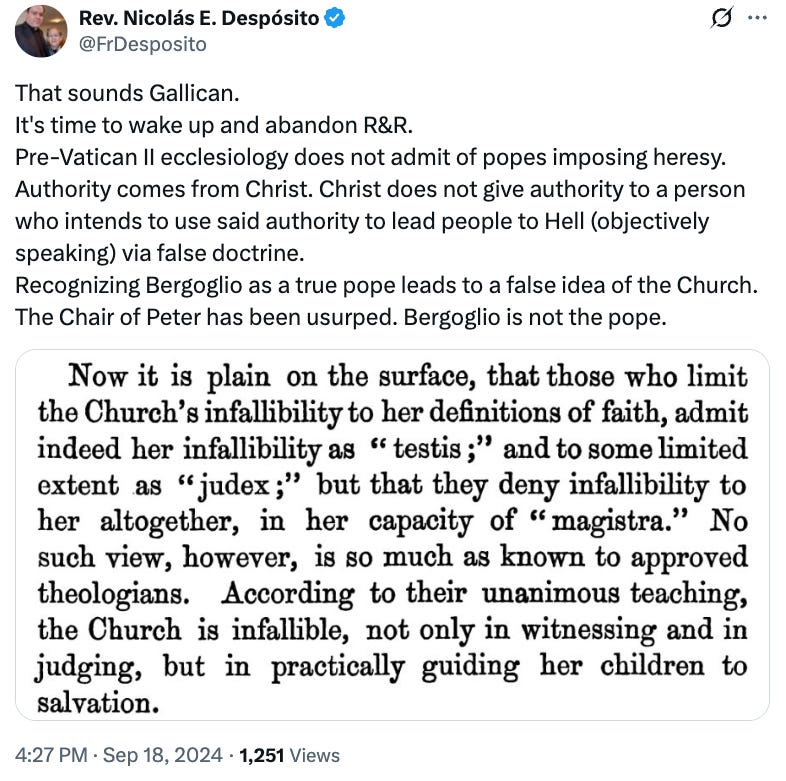
Does anyone expect Fr Despósito to withdraw these tweets and retract his promotion of Ward’s book, now that we have shown that he was “very friendly” with von Hügel?
Of course not – because we all realise that it would be disproportionate and unfair to condemn Ward, simply because of his associations with von Hügel.
But then why is this considered a legitimate stick with which to beat Cardinal Newman? The answer is clear: anything is a good enough stick with which to beat Newman, no matter how unjust, nonsensical or pesonally contradictory – because the condemnation is an a priori matter, and is apparently impervious to contrary argument or evidence.
We mention in passing that the same Ward cited by Fr Despósito – and many other critics of Newman – praised the work which contains the comments critiqued by Bishop Sanborn.
Consider also the apparent honours given to Baron von Hügel by Cardinal Manning, another darling of the anti-Newman brigade:
“Grander ecclesiastical contacts occurred when Cardinal Manning reopened the parish church on 5th May 1877, and the baron sat next to him at the subsequent luncheon, thus seemingly considered already the most notable parishioner.”14
Von Hügel also met with Pius XI and Pius XII before they were popes, enjoying walks with the latter – and with the former even helping him with aspects of his research and writing.15
Would we want to insinuate something about these men too?
Of course not. Von Hügel’s biographer gives his family prominence as a much more common-sense explanation for his standing with these Churchman, in relation to Dr Vaughan (who was later Cardinal Archbishop of Westminster), Bishop Hedley and Newman himself:
“Breakfast with Dr. Vaughan, then Bishop of Salford, is explained by his mother-in-law’s friendship with the future cardinal. What with this, correspondence with Newman, and intimacy with Dr. Hedley, who stayed with them, it is evident that the baron and Lady Mary, combining blood with piety, took their place naturally in the highest Catholic Church society.”16
Should Newman have shunned von Hügel?
Before considering whether Newman should have shunned von Hügel, we should ask whether he can be negatively judged for not doing something that men like Bishop Hedley, Cardinal Ratti, Cardinal Pacelli, Cardinal Manning, Bishop Vaughan and W.G. Ward also did not do – at least, without this negative judgment rebounding on to them.
We are left wondering, again, why Newman is criticised for that which is passed over or praised in others. Once again, “inconsistency is a sign of error.”
But in any case, it would be wrong to suggest that friendship or friendly associations with a liberal, modernist or a sceptic automatically taints a man by association.
As is clear from his life, writing and correspondence, Newman was animated by a love for souls and a desire to help everyone become and remain a Catholic. In this case, as we have already mentioned, some of Newman’s letters suggest that he (like Cardinal Pacelli and others) were trying to help von Hügel, a prominent and influential layman, stay within the bounds of orthodoxy.
Further, neither Newman, nor indeed most people, believe that the best way of achieving this is by privately deciding to shun everyone who is teetering on the edge, or who has already fallen – even if such shunning can indeed be necessary at times.
As Our Lord said:
“For the Son of man is come to save that which was lost. What think you? If a man have an hundred sheep, and one of them should go astray: doth he not leave the ninety-nine in the mountains, and goeth to seek that which is gone astray? And if it so be that he find it: Amen I say to you, he rejoiceth more for that, than for the ninety-nine that went not astray. Even so it is not the will of your Father, who is in heaven, that one of these little ones should perish.” (Matt. 18.11-14.)
While one may eventually need to treat one who “will not hear the Church” as “the heathen and the publican,” the facts of this case make it seem a very unworthy basis of condemning Newman.
Conclusion to all pieces
To summarise, there is little evidence in Newman’s correspondence for suggesting that Newman was ‘very friendly’ with von Hügel. There is still less in de la Bedoyere’s biography, which is precisely where we would expect to find such evidence, if it existed.
But this matter of von Hügel is, as I mentioned, a mere addendum to the more substantial accusations, against which I have already presented a defence here, here and here.
Those accusations are unjust falsehoods. The burden of proof for these claims about Newman – both those which refer to von Hügel, and the other calumnies addressed – lies firmly on Bishop Sanborn’s shoulders.
For these reasons, it is important for those who make such accusations, as Bishop Sanborn has done, not to retreat into what St Pius X called a “conspiracy of silence” when challenged, but to prove their claims, and refute the defences offered – or to retract them, and make restitution for the unjust assault on Newman’s reputation.
Read Next:
Bishop and Cardinal Mini-Series
Part I: Is Cardinal Newman’s idea of conscience ‘precisely modernist,’ as Bishop Sanborn claims?
Part IIa: Bishop Sanborn, and Cardinal Newman’s ‘Proof from Conscience’
Part III: Bishop Sanborn’s attempt to link Cardinal Newman with Baron von Hügel
Books
Newman – Letter to the Duke of Norfolk
Newman – An Essay on the Development of Christian Doctrine
Newman – The Idea of a University
Bishop E.T. O’Dwyer – Cardinal Newman and the Encyclical Pascendi Dominici Gregis
Fr E.D. Benard – A Preface to Newman’s Theology
C. Michael Shea – Newman’s Early Roman Catholic Legacy, 1845-1854
Articles
See our Newman archive here – with some highlights below:
Follow on Twitter, YouTube and Telegram:
‘Suspended magisterium?’, on In Veritate, March 26 2019. Accessed 29 Nov 2023 from https://inveritateblog.com/2019/03/26/suspended-magisterium/
Cited in Benard, p. 156
Michael De la Bedoyere, The Life of Baron von Hügel, p 8. J.M. Dent, London, 1951.
Cf. the practice followed in his early married life, in the late 1870s:
‘Mass and communion twice a week (a regular habit maintained when health would allow through life) and confession often more than once a week, together with frequent visits to the Blessed Sacrament, were the outward religious routine.’ Ibid. 23-4
Cf. the letters in ibid., 29-31
Ibid. 32.
Letters from Baron Friedrich von Hügel to a Niece, ed. Gwendolen Greene, p 116. J.M. Dent & Sons Ltd, London.
Cf. de la Bedoyere pp 23-37
Ibid. throughout.
Ibid. p. 34
Ibid.
Ibid. p. 35
James McMullen Rigg, William George Ward – A Short Biography. Oxford, Oxford University Press, 1990. E-text used, no page number available.
Ibid. 24
For instance de la Bedoyere writes:
‘… most interesting of all perhaps to-day, Don Eugenio Pacelli with whom the baron had constant walks and who at the time was most forthcoming in regard to the biblical and other questions interesting von Hügel.’ 88
‘In Rome that spring the baron, who had resumed his bicycling and who was frequently meeting two future popes, Don Ratti and Don Pacelli, also often saw a personage destined soon to become much more important, the half English Mgr. Merry del Val, with whom, as with Cardinal Vaughan, he was then persona grata because of family connections.’ 125
‘At the Ambrosiana he was helped in his research by ‘Scrittore Ratti,’ the future Pius XI…’ 130
Regarding the censorship and surveillance of a particular journal, de la Bedoyere even tries portray a certain intimacy and confidence with the future Pius XI:
‘A very strange fate brought him at this moment into discussion of the whole position with Don Achille Ratti -the future Pius XI – in the Ambrosian Library. In his Diary for the 12th December 1907, he notes: ‘Saw Don Achille ratti: he talks to me about “Rinn.” in characteristically scholastic, traditional way, tho’ with kindly feeling fo the young men.”
‘Don Ratti was in fact in close relations with Scotti, a disciple of his, and was most anxious to see the matter settled. He proposed to the baron a settlement along the lines of an apology for the way the Review had criticized Pascendi, in return for which it would be allowed to continue under the surveillance of a broad-minded censor, like the Dominican Genocchi […]’ 206-7.
Ibid. 24


